Kabuto
Kabuto (兜, 冑) is a type of helmet first used by ancient Japanese warriors, and in later periods, they became an important part of the traditional Japanese armour worn by the samurai class and their retainers in feudal Japan.
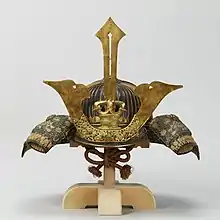
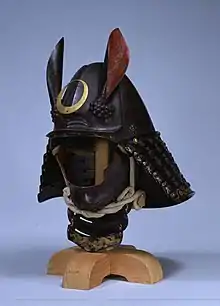
Note that in the Japanese language, the word kabuto is an appellative, not a type description, and can refer to any combat helmet.
History
Japanese helmets dating from the fifth century (long before the rise of the samurai class) have been found in excavated tombs. Called mabizashi-tsuke kabuto (visor-attached helmet), the style of these kabuto came from China and Korea and they had a pronounced central ridge.[1][2]
Kabuto, which is now known as a samurai helmet, first appeared in the 10th century Heian period with the appearance of ō-yoroi. In the Sengoku period in the 16th century, when battles between samurai changed into gun and group battles, ō-yoroi and dō-maru went out of fashion and tosei-gusoku (gusoku) was born, and the style of kabuto changed greatly.[3]
In the Edo period, when the Tokugawa shogunate defeated the Toyotomi clan at Summer Siege of Osaka and the society became peaceful, armor with a revival of the medieval times became popular, and ō-yoroi and dō-maru style kabuto were made again.[4]
The kabuto was an important part of the equipment of the samurai, and played a symbolic role as well, which may explain the Japanese expressions, sayings and codes related to them. One example is Katte kabuto no o wo shimeyo (lit. "Tighten the string of the kabuto after winning the war"). This means don't lower your efforts after succeeding (compare to "not to rest on one's laurels").[5] Also, kabuto wo nugu (lit. "to take off the kabuto") means to surrender.[6]
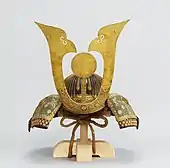 Dō-maru kabuto. Muromachi period, 15th century, Tokyo National Museum, Important Cultural Property
Dō-maru kabuto. Muromachi period, 15th century, Tokyo National Museum, Important Cultural Property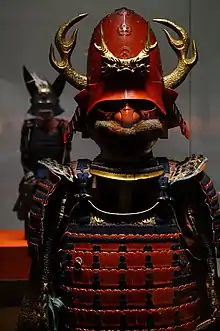 Gusoku kabuto. Azuchi–Momoyama period, 16th-17th century, Suntory Museum of Art
Gusoku kabuto. Azuchi–Momoyama period, 16th-17th century, Suntory Museum of Art Kuroda Takamasa's gusoku kabuto. Edo period, 17th century, Tokyo National Museum
Kuroda Takamasa's gusoku kabuto. Edo period, 17th century, Tokyo National Museum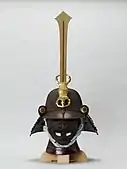 Gusoku kabuto. Edo period, 17th century, Tokyo National Museum, Important Cultural Property
Gusoku kabuto. Edo period, 17th century, Tokyo National Museum, Important Cultural Property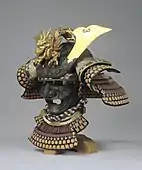 Dō-maru style kabuto with a medieval revival style. Edo period, 19th century, Tokyo National Museum.
Dō-maru style kabuto with a medieval revival style. Edo period, 19th century, Tokyo National Museum.
Parts of the kabuto
![]() Media related to Kabuto (individual parts) at Wikimedia Commons
Media related to Kabuto (individual parts) at Wikimedia Commons
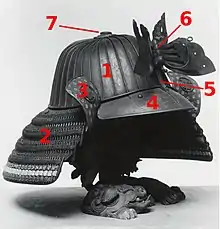
- hachi
- shikoro
- fukigaeshi
- mae-zashi
- hari-date
- datemono
- hachimanza
The basic parts of the kabuto include:
- Hachi, a dome composed of overlapping elongated plates called tate hagi-no-ita
- Tehen, a small opening at the top of the hachi, usually fitted with a tehen kanamono (an ornamental grommet, often resembling a chrysanthemum)
- Mabizashi, a brim or visor on the front of the hachi
- Ukebari, a cloth lining inside the hachi
- Tsunamoto, mounting points for attaching crests
- Kasa jirushi no kan, a ring at the back of the hachi for securing a kasa jirushi (helmet flag)
- Fukigaeshi, wing-like or ear-like projections to the sides of the hachi
- Shikoro, a suspended neck guard composed of multiple overlapping lames
- Shinobi-no-o (chin cord), often used to secure the mengu (facial armour)
A typical kabuto features a central dome constructed of anywhere from three to over a hundred metal plates riveted together. These were usually arranged vertically, radiating from a small opening in the top. The rivets securing these metal plates to each other could be raised (a form known as hoshi-bachi) or hammered flat (a form known as suji-bachi); another form, called hari bachi, had the rivets filed flush. Some of the finer hachi were signed by their makers, usually from one of several known families, such as the Myochin, Saotome, Haruta, Unkai, or Nagasone families.
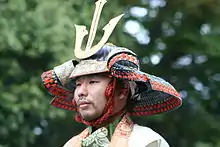
A small opening in the top of the kabuto, called the tehen or hachimanza (seat of the war god, Hachiman), was thought to be for passing the warrior's top knot through. Although this practice was largely abandoned after the Muromachi period, this opening may have been retained for purposes of ventilation or simply as an artifact of how the plates were riveted together.[7] The tehen was usually decorated with tehen kanamono, which were rings of intricately worked, soft metal bands often resembling a chrysanthemum.[7][8] Zunari kabuto and momonari kabuto were two helmet forms that did not usually have an opening at the top.
Kabuto incorporated a suspended neck guard called a shikoro, usually composed of three to seven semicircular, lacquered metal or oxhide lames, attached and articulated by silk or leather lacing, although some shikoro were composed of 100 or more small metal scales in a row.[9] This lamellar armour style, along with kusari (mail armour), was the standard technology of Japanese body armour, and some shikoro were made of mail sewn to a cloth lining (a form called kusari shikoro).
The kabuto was secured to the head by a chin cord called shinobi-no-o, which would usually be tied to posts or hooks on the mengu (facial armour) or simply tied under the chin.
Kabuto are often adorned with crests called datemono or tatemono;[10] the four types of decorations were the maedate (frontal decoration), wakidate (side decorations), kashiradate (top decoration), and ushirodate (rear decoration). These can be family crests (mon), or flat or sculptural objects representing animals, mythical entities, prayers or other symbols. Horns are particularly common, and many kabuto incorporate kuwagata, stylized antlers.
 Various hachi shapes:
Various hachi shapes:- Nari akoda
- Goshozan
- Heichozan
- Koseizan
- Tenkokuzan
- Zenshozan
 Many wavy shaped hagi-no-ita plates form a hachi. A colourful tehen kanamono can be seen at the top
Many wavy shaped hagi-no-ita plates form a hachi. A colourful tehen kanamono can be seen at the top Kasa jirushi no kan, a ring for securing a kasa jirushi (helmet flag) to the hachi
Kasa jirushi no kan, a ring for securing a kasa jirushi (helmet flag) to the hachi Lacquered iron shikoro (neck guard)
Lacquered iron shikoro (neck guard) The fukigaeshi can be seen to both sides of the mabizashi (brim), and the shinobi-no-o (cord) secures the mengu (facial armour)
The fukigaeshi can be seen to both sides of the mabizashi (brim), and the shinobi-no-o (cord) secures the mengu (facial armour)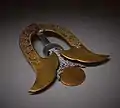 Maedate, c. 1800-1894, from the Oxford College Archives of Emory University
Maedate, c. 1800-1894, from the Oxford College Archives of Emory University Various kabuto maedate (front crests)
Various kabuto maedate (front crests) Maedate tsunamoto (mounting point for front crest)
Maedate tsunamoto (mounting point for front crest) Wakidate tsunamoto (mounting point for side crest)
Wakidate tsunamoto (mounting point for side crest)
Types of kabuto

Suji bachi kabuto
Suji bachi kabuto is a multiple-plate type of Japanese helmet with raised ridges or ribs showing where the helmet plates come together; the rivets may be filed flat or they may be left showing, as in the hoshi-bachi kabuto.
Hoshi-bachi kabuto
Hoshi-bachi kabuto (star helmet bowl) with protruding rivet heads, have large rivets (o-boshi), small rivets (ko-boshi) and a rivet with a chrysantemoid-shaped washer at its base (za-boshi). Hoshi-bachi kabuto could also be suji bachi kabuto if there were raised ribs or ridges showing where the helmet plates came together.
Hari bachi kabuto
Hari bachi kabuto is multiple-plate Japanese hachi with no ribs or ridges showing where the helmet plates come and the rivets are filed flush.
Zunari kabuto
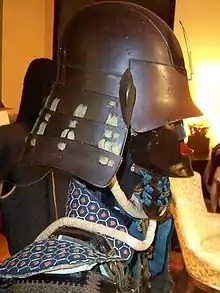
The zunari kabuto is a simple, five-plate design.
Tatami kabuto
A great number of simpler, lightweight, folding, portable armours for lower-ranking samurai and foot soldiers (ashigaru) were also produced. These were called tatami armour, and some featured collapsible tatami kabuto (also called choshin-kabuto), made from articulated lames.[8][11][12] Tatami kabuto did not use rivets in their construction; instead, lacing or chain mail was used to connect the pieces to each other.
Kaji kabuto
Kaji kabuto were a type of helmet worn by samurai firemen.[13]
Jingasa
Jingasa were war hats made in a variety of shapes, worn by ashigaru (foot soldiers) and samurai, which could be made from leather or metal.[14]
Kawari kabuto or strange helmet
During the Momoyama period of intense civil warfare, kabuto were made to a simpler design of three or four plates, lacking many of the ornamental features of earlier helmets. To offset the plain, utilitarian form of the new helmet, and to provide visibility and presence on the battlefield, armorers began to build fantastic shapes on top of the simple helmets in harikake (papier-mâché mixed with lacquer over a wooden armature), though some were constructed entirely of iron. These shapes mimicked forms from Japanese culture and mythology, including fish, cow horns, the head of the god of longevity, bolts of silk, head scarves, Ichi-no-Tani canyon, and axe heads, among many others. Some forms were realistically rendered, while others took on a very futuristic, modernist feel.
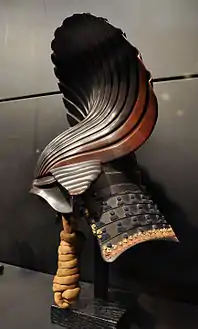 Harikake kabuto, a type of kawari kabuto which used papier-mâché mixed with lacquer for the elaborate decoration (the shell) on an iron bowl, beginning of the Edo Period, 17th century . Ann and Gabriel Barbier-Mueller Museum, Dallas (Texas)
Harikake kabuto, a type of kawari kabuto which used papier-mâché mixed with lacquer for the elaborate decoration (the shell) on an iron bowl, beginning of the Edo Period, 17th century . Ann and Gabriel Barbier-Mueller Museum, Dallas (Texas)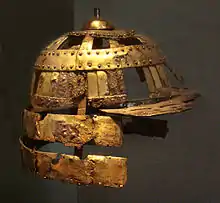 A Kofun period (fifth century) early kabuto made of iron and gilt copper, from Ise Province
A Kofun period (fifth century) early kabuto made of iron and gilt copper, from Ise Province_za-boshi_suji_bachi_kabuto.jpg.webp) Za-boshi kabuto (chrysantemoid-shaped washer at the base of the rivet), this is also a suji bachi kabuto, as it has raised ridges
Za-boshi kabuto (chrysantemoid-shaped washer at the base of the rivet), this is also a suji bachi kabuto, as it has raised ridges Eboshi kabuto
Eboshi kabuto Eboshi kabuto
Eboshi kabuto Kaji kabuto
Kaji kabuto Jingasa, ashigaru type, constructed from hardened leather (nerigawa)
Jingasa, ashigaru type, constructed from hardened leather (nerigawa) A kawari kabuto
A kawari kabuto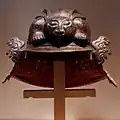 A kawari kabuto
A kawari kabuto
References
- Bryant, Anthony J. (1991). Early Samurai: 200-1500 AD. Angus McBride, Ill. Osprey Publishing. p. 45. ISBN 9781855321311.
- Sinclaire, Clive (2004). Samurai: The Weapons and Spirit of the Japanese Warrior. Globe Pequot Press. p. 26. ISBN 9781592287208.
- 式正の鎧・大鎧 Costume Museum
- 甲冑に見る江戸時代展5 武士と武人の甲冑像 Fukuoka City Museum
- 勝って兜の緒を締めよ weblio国語辞典
- 兜を脱ぐ weblio国語辞典
- Louis, Thomas; Ito, Tommy (2006). Samurai: The Code of the Warrior. New York: Sterling Publishing Co. p. 94. ISBN 9781402763120.
- Ratti, Oscar; Westbrook, Adele (1973). Secrets of the samurai: a survey of the martial arts of feudal Japan. Boston, Massachusetts: Tuttle Publishing. p. 211. ISBN 9780804816847.
- The Encyclopedia Americana: a library of universal knowledge, Volume 15 p.774
- Bryant, Anthony J. (1994). Samurai 1550-1600. Angus McBride, Illust. Oxford: Osprey Publishing. p. 25. ISBN 9781855323452.
- Transactions of the Asiatic Society of Japan - Page 279 Asiatic Society of Japan - 1881.
- Arms and Armor of the Samurai Ian Bottomley, Anthony Hopson Random House Value Publishing, 1993 p.92
- Yasuka, Author (2013-08-26). "The Samurai Facial Armor and Helmet". KCP International. Retrieved 2019-08-26.
- Deal, William E. (2007). Handbook to life in medieval and early modern Japan. Oxford: Oxford University Press. p. 172. ISBN 978-0-19-533126-4.
External links
![]() Media related to Kabuto at Wikimedia Commons
Media related to Kabuto at Wikimedia Commons